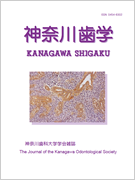- HOME
- > 一般の方
- > バックナンバー:神奈川歯学
- > 35巻2/3号
- > アブストラクト
アブストラクト(35巻2/3号:神奈川歯学)

Japanese
| Title : | In vitroにおけるフィッシャーシーラントからの溶出物同定とレジンモノマーの内分泌撹乱作用の検討 |
|---|---|
| Subtitle : | |
| Authors : | 黒川孝一, 松澤光洋*, 倉田茂昭** |
| Authors(kana) : | くろかわこういち, まつざわみつひろ, くらたしげあき |
| Organization : | 神奈川歯科大学歯科補綴学教室, *神奈川歯科大学小児歯科学教室, **神奈川歯科大学歯科生体工学教室 |
| Journal : | 神奈川歯学 |
| Volume : | 35 |
| Number : | 2/3 |
| Page : | 69-81 |
| Year/Month : | 2000 / 9 |
| Article : | 原著 |
| Publisher : | 神奈川歯科大学学会 |
| Abstract : | 近年, 外因性内分泌撹乱化学物質(環境ホルモン)と呼ばれる合成化学物質が自然環境やヒトの健康を脅かす存在として大きくクローズアップされている. なかでもbisphenol A(BPA)は, 内分泌撹乱作用を有すると疑われる化学物質として環境庁がリストアップした67物質の一つであり1), 河川水, 海水中のみにとどまらず食品用容器などからも多数の検出例が報告され2~6), 日常生活で比較的身近に存在する環境ホルモンである. しかし, 環境に対する影響や生体内動態については不明であり, 早急な対策が求められている. BPAは, ポリカーボネート, エポキシ樹脂, ポリサルホンやポリエステル樹脂などのプラスチック製品の原料として広く利用され, 歯科材料においてもそれら樹脂はレジン系のフィッシャーシーラントや充填材料, 矯正用ブラケット, 義歯床, 人工歯など広範囲に用いられている. BPAがエストロゲン作用を有することは, 既にDoddsら7)により卵巣摘出ラットを用いた実験で証明されている. |
| Practice : | 歯科学 |
| Keywords : | Bisphenol A, MCF-7, レジンモノマー |
English
| Title : | Identification and Quantification of Resin Monomers Released from the Fissure Sealants, and Estrogenic Activity of the Monomers |
|---|---|
| Subtitle : | |
| Authors : | Koichi KUROKAWA, Mitsuhiro MATSUZAWA*, Shigeaki KURATA** |
| Authors(kana) : | |
| Organization : | The 1st Department of Prosthetic Dentistry,Kanagawa Dental College, *Department of Pediatric Dentistry,School of Dentistry,Kanagawa Dental College, **Department of Dental Bioengineering and Biotechnology,Kanagawa Dental College |
| Journal : | Kanagawa Shigaku |
| Volume : | 35 |
| Number : | 2/3 |
| Page : | 69-81 |
| Year/Month : | 2000 / 9 |
| Article : | Original article |
| Publisher : | Kanagawa Odontological Society |
| Abstract : | This study sought to determine whether the commercially available light-cured fissure sealants contain releasable bisphenol A (BPA) ; BPA and other components released from the sealants eluted with ethanol or artificial saliva were quantified. The effects of authentic monomers of the sealants tested on cell proliferation and expression of estrogen- and progesteron-receptor mRNA of human breast cancer cells (MCF-7) and human pulp cells (HPC) were also investigated. Triethylene glycol dimethacrylate (TEGDMA) and 2,2-bis 「4- (2-hydroxy-3-methacryloyloxy-propoxy) phenyl」 -propane (Bis-GMA), but not BPA, were able to quantified by high-performance liquid chromatography when the sealants were eluted with ethanol ; only (detectable amounts of) TEGDMA was released from the sealants eluted with artificial saliva. 17β-Estradiol (E_2 ), diethylstilbestrol (DES) and BPA produced an induction of cell proliferation in MCF-7, but not in HPC. The observed potency of BPA on the cell proliferation was 1/1,000 of that of E_2 . The authentic monomers tested (TEGDMA, Bis-GMA, and 2- hydroxylethyl methacrylate) had no effect on the cell proliferation of MCF-7 and HPC. The expression of progesteron-receptor mRNA, but not estrogen-receptor mRNA, of MCF-7 and HPC were evident in E_2 -, DES- and BPA-treated cells ; in contrast to this, the authentic monomers were without effect. It is suggested that primary monomer released in response to elution with ethanol and artificial saliva from the commercially available sealants tested in the present study is TEGDMA, and can be postulated that if BPA is released from the sealants, even if the amount is undetectable levels under our experimental system, this compound may act as an estrogenic substance. |
| Practice : | Dentistry |
| Keywords : |
